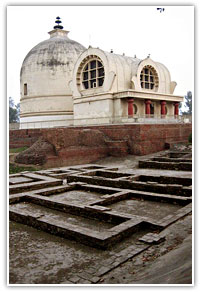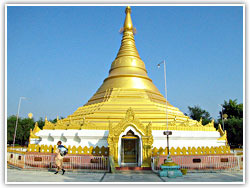|
|
Buddhist Pilgrimage in North India
.............................................................................................................................................................................. |
|
|
|
From Siddharth to Sakyamuni and
finally to the Buddha or the Enlightened one, it
has been an incredible transformation of a prince
to an enlightened teacher, who walked on the earth
more than 2500 years ago. Upon seeing sorrow,
misery, pain and death, prince Siddharth decided
to discover their causes and means of overcoming
their occurrences. Thus renouncing worldly
pleasures and leaving home and family behind, he
traveled from place to place until he finally
attained enlightenment by meditating under the Bodhi Tree. Then, he preached the truth he
discovered, and exhorted his disciples to follow
the Eight Fold Path for the cessation of the
endless cycle of birth and re-birth. There are
several major sights and schools of Buddhist
learning in North India which reflects the life
and teachings of the Buddha and the influence of
Buddhism. Some of these famous Buddhist Places in
North India are Kapilavastu, |
 |
|
|
Kaushambi, Kushinagar, Lumbini, Sankisa, Sarnath,
Sravasti, Tabo.
Kapilavastu (Piprahwa)
Kapilavastu is situated about 110 kms. from Gorakhpur in
Uttar Pradesh. Kapilavastu was the capital city of the
Sakya clan, and one of the earliest republics. In
Kapilvastu, the prince Siddharth (Gautam Buddha) spent
his childhood. Here he saw sorrow, pain, disease and
death. Then, finally when he saw the Sadhu who had
conquered all these, he decided to renounce all worldly
riches and pleasures to seek truth and embark on the
path of salvation. This place holds significant value
for Buddhist pilgrims and has several Stupas. The
archaeological excavations done here have revealed stone
caskets that contains the relics of Buddha.
Kaushambi
Kaushambi is situated about 54 kms. from Allahabad in
Uttar Pradesh. Kaushambi was visited by Buddha in the
6th and 9th year after his enlightenment. He delivered
several sermons here, elevating it to a centre of
learning for Buddhists. Today one can see the ruins of
an Ashokan Pillar, an old fort and the Ghositaram
Monastery. The archaeological excavations which were
done here have yielded a large number of sculptures,
figures, coins, punch-marked and cast coins and
terracotta sculptures which show the importance of the
city in the olden days.
Kushinagar
Kushinagar is situated about 55 kms. away from Gorakhpur
and a revered place for Buddhist pilgrims. Kushinagar or
Kushinara of Yore is the place where the Lord Buddha
died, at the age of 80 and was cremated and achieved the
state of Parinirvana. The last rites were performed with
all the honour that is due to a universal monarch (Chakravartin),
as he was held in reverence by all people. The kings of
eight Indian states of the Gangetic basin came for the
funeral rites and divided his ashes in eight parts. Each
king carried these back to his kingdom and built a
‘Stupa’ over the mortal remains of Lord Buddha. The main
tourist attraction in Kushinagar is the Mahaparinirvana
temple, containing the reclining statue of Lord Buddha.
This temple is dedicated to the Lord Buddha where he
attained Parinirvana. The statue of Buddha was excavated
in 1876 at the temple, and one of the most momentous
sight for the devotees. |
|
|
|
Lumbini
Lumbini is only a few kilometers across the Indian
border in Nepal. It is a small town in the Terai
region, situated south of the foothills of the
Churia Range. Lumbini is the most important site
for the followers of Lord Budha and those
interested in Buddhism. The Lord Buddha was born
in Lumbini, around 544 BC. His mother was on her
way to her father’s house when he was born at a
small place where she had halted. Emperor Ashoka
visited Lumbini in 259 BC to worship at the
|
 |
|
|
place
where the Buddha was born. In order to identify the
place with Lord Buddha, he erected a giant pillar which
is the only proof that Lord Buddha was born here.
Sanchi
Sanchi is an important Buddhist pilgrimage center of
India. Sanchi is situated about 68 km. north of Bhopal
on a hill rising from the plains. This hill is topped by
some of the oldest and most interesting Buddhist shrines
in the country. The imposing hilltop site offers
commanding views of the surrounding countryside. Sanchi
is a peaceful town crowned by a group of stupas and
abandoned monasteries that are one of the most important
Buddhist sites in India. Sanchi is known for the famous
stupa, built by the Emperor Ashoka.
Sankisa
Sankisa is situated in central Uttar Pradesh. It is
believed to be the place where Buddha, along with Brahma
and Devraj Indra descended after giving sermons to his
mother in heaven. At the place where he descends, stands
a temple with a statue of the Buddha. Sankisa is also
known for the temple dedicated to Bisari Devi, a
colossal Shiva Linga and an excavated Ashokan Elephant
Pillar. A large fair is also held in Sankisa in the
month of Shravan (July-August). |
|
|
|
Sarnath
Sarnath, a world famous Buddhist site is situated
about 10 kms. from Varanasi. After attaining
enlightenment at Bodhgaya, Lord Buddha went to
Sarnath. In Sarnath, the stream of the Buddha's
teaching first flowed. At this place, the Buddha
encountered the five men who had been his
companions of earlier austerities. Here in the
Deer Park, he delivered his first sermon, or in
religious language, set in motion the Wheel of Law
(Maha-Dharmachakra Pravartan) in Buddhism. The
Emperor Ashoka, who spread the Buddha's message of
love and compassion throughout his vast empire,
visited Sarnath around 234 BC, and erected
magnificent stupas and structures. Sarnath became
one of the great centres of Buddhism.
Sravasti |
 |
|
|
Sravasti was an important city at the time of Buddha.
Buddha lived and preached at the monastery of Jetavana
in Sravasti. He also performed some miracles here to
convince the non-believers about the truth of his
religion. After his death, the monastery enjoyed royal
patronage, particularly from Ashoka and it remained
active until the 11th century. The remains of the city
and monastery are around the current villages of Maheth
and Seth which are no more than half a kilometer apart.
Maheth on the banks of the Achiravati river consists of
an earthern embankment and the ruins of two stupas and
temples. Seth contains the remains of the Jetavana
monastery.
Tabo
Tabo was founded in 996 AD. by the initiative of the
great teacher Rinchensang Po, also known as Mahaguru
Ratnabhadra. In June-July 1996, Tabo celebrated
millennium of its glorious existence. Tabo is often
known as the Ajanta of the Himalayas, due to its
breathtaking murals and stucco images. Here, the art of
religion and deep faith was also born. The Tabo
Monastery at a height of 3050 meters is a complex that
holds 9 temples, 23 chortens, a monks chamber and an
extension that houses the nuns chamber. This core is
bounded by an earthen wall and covers an area of 6300
square meters. The contemporary monastic structures are
located near the monastery. On the sheer cliff-face
above the enclave are a series of caves which were used
as dwelling units by the monks and includes an assembly
hall. The dim traces of the paintings that once adorned
the rock face are visible on the caves. |
|